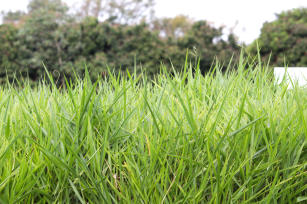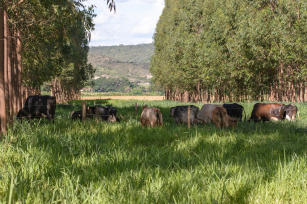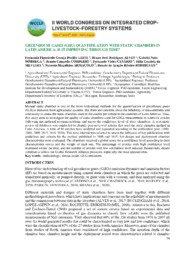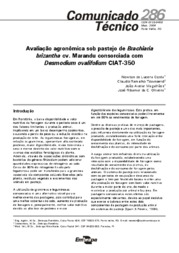The introduction of the legume had the same impact of an annual application of 150 kilos of nitrogen fertilizer per hectare in the pasture. Four-year study shows that the use of Desmodium ovalifolium can reduce time to slaughter by 30% . Reducing how long is taken until the animal slaughter represents less costs for farmers and less greenhouse gas (GHG) emissions. Legume improves bovine digestion and reduces methane emissions. A study conducted for four years has revealed that the intercropping of Brachiaria brizantha cv. Marandu, also known as marandu grass, with the forage legume Desmodium ovalifolium (desmodium) increases the weight of grazing cattle in 60% in comparison with pastures without the use of nitrogen fertilization. "The introduction of the legume had the same impact of an annual application of 150 kilos of nitrogen fertilizer per hectare in the pasture", explains Robert Boddey, a researcher at Embrapa Agrobiology. Newly published in the journal Grass & Forage Science, one of the most important in the area of forage cultivation, the study also points out that the use of Desmodium ovalifolium can reduce time to slaughter by 30%, which represents less costs for breeders. "Reducing time to slaughter also entails less enteric methane emissions (cow burps) into the atmosphere", Boddey adds. An adult animal in the pasture emits between 50 and 60 kilos of methane per year. The use of desmodium in the pasture not only cuts emissions of enteric methane but also of nitrous oxide by allowing a reduction in the use of nitrogen fertilization on pastures. The nitrous oxide is the most powerful gas of effect greenhouse. According to research, each kilo of nitrogen applied over the field emits an amount of nitrous oxide that is equivalent to at least four kilos of CO2. Learn more about desmodium Desmodium ovalifolium is a perennial forage legume of Asian origin. The plant is a subshrub that can reach up to a meter of height. The stem is practically hairfree, except in the extremities, where there is a fine and silky hairiness. When the stem's lower knots are in contact with the soil, they easily take root. The leaves are trifoliate with oval leaflets, the terminal one of which is larger than the side ones. The flowers are purple or dark pink, and become bluish after their full bloom. Learn more about its management here. Reducing the use of nitrogen fertilizers in pastures allows the elimination of fossile CO2 emissions resulting from their manufacture, transportation and application to the fields. It is estimated that for each 100 kilos of nitrogen fertilizer there is the emission of 450 kilos of CO2 equivalent. "On top of such environmental gain, there is the possibility of reducing expenses with fertilizers, which is currently around 300 dollars per hectare of pasture", the scientist recalls. Segundo Urquiaga, another Embrapa researcher, remarks that the results obtained with the desmodium have gained special importance because the high cost of fertilizers makes Brazilian pastures have limited nitrogen fertilization. "Currently, it is estimated that less than 5% of Brazilian pastures receive some type of nitrogen fertilizer", Urquiaga states. Resistance to the use of leguminous plants The use of leguminous plants in the pastures is not an option many breeders adopt. "There is resistance among farmers not only because the seeds are expensive, but also because the species used so far, especially Stylosanthes, do not persist when associated with Brachiaria grasses", Boddey explains. After some time in the field the leguminous plant wanes or dies, ant it is necessary to renew the pasture, which entails further costs and work. The Embrapa researcher states that this does not occur with desmodium, and it is possible have the legume in the pasture for over nine years. "As it is a stoloniferous plant, that is, its roots or culms grow along the ground and originate a new plant, it is not necessary to keep renewing the pasture", Boddey clarifies. According to him, if the leguminous plants whose reproduction is stolon-based are adequately managed in the pasture, they will persist there. "In desmodium's case, the solution is to have the cattle graze it when the plant height reaches 30 cm and remove the animals when the average height is 15 cm", he recommends. Next steps The scientists explain that one of the main sources of methane emissions to the atmosphere is "cow burps", and they can be more or less intense depending on the cattle's diet. Because desmodium is a species with high tannin content, the researchers understand that it can help digestion and also contribute to reducing emissions of the gas. Tannin is a chemical compound especially present in the rinds, stems, leaves and seeds of leguminous plants. GHG emission studies in fields and in laboratories are already underway. "Assessing the animal is rather complicated, because it is necessary to also evaluate forage consumption and animal performance", Boddey reports. For that purpose, the researchers use a special collector connected to the animal, which for a period collects the emitted gas that is later evaluated in laboratory. Preliminary data show that the reduction can be higher than 10%. The research For four years, this study was performed by Embrapa Agrobiology at the Cocoa Farming Plan Executive Commission's (Ceplac) Animal Science Experimental Station in the town of Itabela, south of Bahia. It compared three pasture areas: the first mixing desmodium and Brachiaria brizantha cv. Marandu grass without the application of nitrogen fertilizer, the second one with the cultivation of such marandu grass with the annual application of 150kg of nitrogen (fertilized pasture), and a third area with cultivation of the Brachiaria grass without nitrogen fertilization. The use of desmodium in the pastures of this Atlantic rainforest region has been evaluated by Embrapa since 2009. Such research goals are to verify the system's nitrogen incorporation capacity, reduce greenhouse gas emissions, and make Brazilian pastures more productive. "It is important to highlight that the results obtained with Desmodium ovalifolium are for this biome", the researcher adds. Seeds in cattle feed According to Ceplac researcher Cláudia de Paula Rezende, managing desmodium requires just as much other species. The animal scientist has worked for over two decades assessing the use of this and other leguminous species in pastures. "Farmers need to see their pastures as crop to which they must supply enough nutrients so that they become perennial and can yield results both in the animals and in the system as a whole", the researcher comments. Rezende explains that desmodium can be introduced in the pasture at the time the grass is sown with a few recommendations. "You should not sow them together because the seed of this leguminous plant is very small, and if you place it in the sowing machine with the grass seed the latter will fall first", she warns. Thus she considers adding the desmodium seeds to the cattle feed easier. "If we add around 100 grams of non-scarified seeds, the cattle will ingest them and then defecate in the pasture, so the seeds can be set and grow", the animal scientist explains.
Photo: Cláudia Rezende
![Cláudia Rezende - <i>Desmodium ovalifolium</i> is a perennial forage legume of Asian origin. Picture of desmodium flower. Cláudia Rezende - <i>Desmodium ovalifolium</i> is a perennial forage legume of Asian origin. Picture of desmodium flower.]()
Desmodium ovalifolium is a perennial forage legume of Asian origin. Picture of desmodium flower.
A study conducted for four years has revealed that the intercropping of Brachiaria brizantha cv. Marandu, also known as marandu grass, with the forage legume Desmodium ovalifolium (desmodium) increases the weight of grazing cattle in 60% in comparison with pastures without the use of nitrogen fertilization. "The introduction of the legume had the same impact of an annual application of 150 kilos of nitrogen fertilizer per hectare in the pasture", explains Robert Boddey, a researcher at Embrapa Agrobiology.
Newly published in the journal Grass & Forage Science, one of the most important in the area of forage cultivation, the study also points out that the use of Desmodium ovalifolium can reduce time to slaughter by 30%, which represents less costs for breeders. "Reducing time to slaughter also entails less enteric methane emissions (cow burps) into the atmosphere", Boddey adds. An adult animal in the pasture emits between 50 and 60 kilos of methane per year.
The use of desmodium in the pasture not only cuts emissions of enteric methane but also of nitrous oxide by allowing a reduction in the use of nitrogen fertilization on pastures. The nitrous oxide is the most powerful gas of effect greenhouse. According to research, each kilo of nitrogen applied over the field emits an amount of nitrous oxide that is equivalent to at least four kilos of CO2.
Learn more about desmodium Desmodium ovalifolium is a perennial forage legume of Asian origin. The plant is a subshrub that can reach up to a meter of height. The stem is practically hairfree, except in the extremities, where there is a fine and silky hairiness. When the stem's lower knots are in contact with the soil, they easily take root. The leaves are trifoliate with oval leaflets, the terminal one of which is larger than the side ones. The flowers are purple or dark pink, and become bluish after their full bloom. Learn more about its management here. |
Reducing the use of nitrogen fertilizers in pastures allows the elimination of fossile CO2 emissions resulting from their manufacture, transportation and application to the fields. It is estimated that for each 100 kilos of nitrogen fertilizer there is the emission of 450 kilos of CO2 equivalent. "On top of such environmental gain, there is the possibility of reducing expenses with fertilizers, which is currently around 300 dollars per hectare of pasture", the scientist recalls.
Segundo Urquiaga, another Embrapa researcher, remarks that the results obtained with the desmodium have gained special importance because the high cost of fertilizers makes Brazilian pastures have limited nitrogen fertilization. "Currently, it is estimated that less than 5% of Brazilian pastures receive some type of nitrogen fertilizer", Urquiaga states.
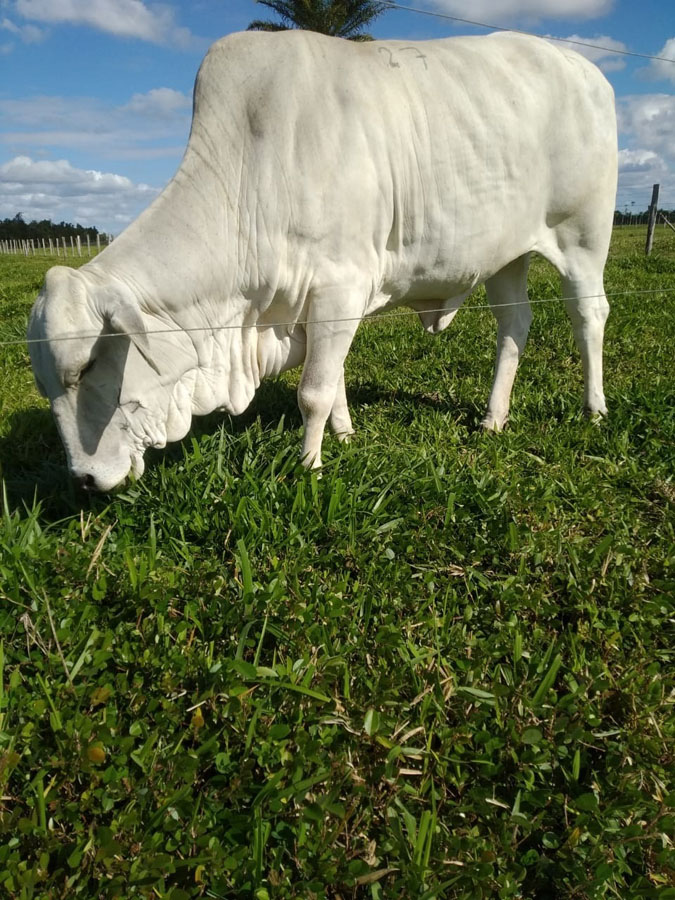 Resistance to the use of leguminous plants
Resistance to the use of leguminous plants
The use of leguminous plants in the pastures is not an option many breeders adopt. "There is resistance among farmers not only because the seeds are expensive, but also because the species used so far, especially Stylosanthes, do not persist when associated with Brachiaria grasses", Boddey explains. After some time in the field the leguminous plant wanes or dies, ant it is necessary to renew the pasture, which entails further costs and work.
The Embrapa researcher states that this does not occur with desmodium, and it is possible have the legume in the pasture for over nine years. "As it is a stoloniferous plant, that is, its roots or culms grow along the ground and originate a new plant, it is not necessary to keep renewing the pasture", Boddey clarifies.
According to him, if the leguminous plants whose reproduction is stolon-based are adequately managed in the pasture, they will persist there. "In desmodium's case, the solution is to have the cattle graze it when the plant height reaches 30 cm and remove the animals when the average height is 15 cm", he recommends.
Next steps
The scientists explain that one of the main sources of methane emissions to the atmosphere is "cow burps", and they can be more or less intense depending on the cattle's diet. Because desmodium is a species with high tannin content, the researchers understand that it can help digestion and also contribute to reducing emissions of the gas. Tannin is a chemical compound especially present in the rinds, stems, leaves and seeds of leguminous plants.
GHG emission studies in fields and in laboratories are already underway. "Assessing the animal is rather complicated, because it is necessary to also evaluate forage consumption and animal performance", Boddey reports. For that purpose, the researchers use a special collector connected to the animal, which for a period collects the emitted gas that is later evaluated in laboratory. Preliminary data show that the reduction can be higher than 10%.
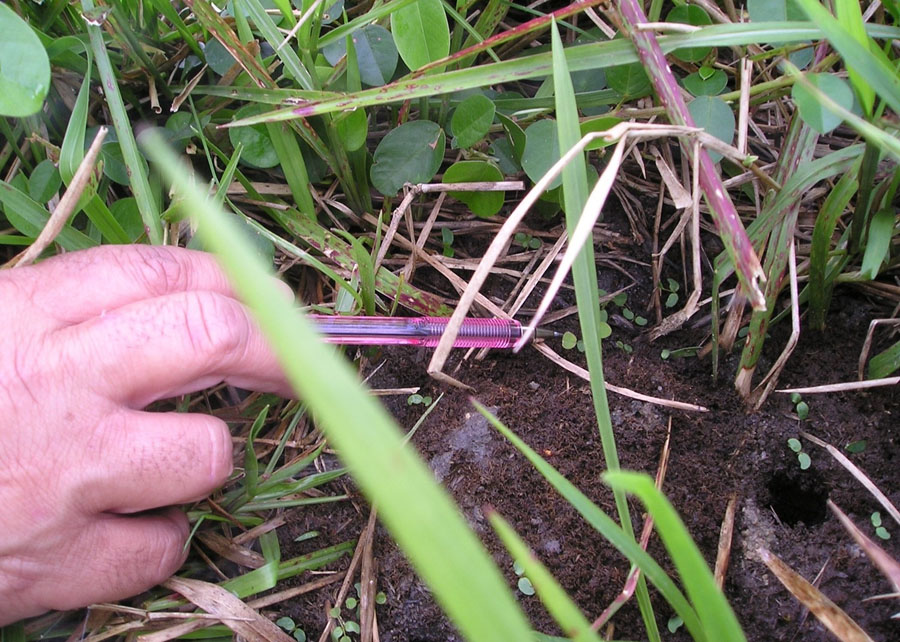 The research The research
For four years, this study was performed by Embrapa Agrobiology at the Cocoa Farming Plan Executive Commission's (Ceplac) Animal Science Experimental Station in the town of Itabela, south of Bahia. It compared three pasture areas: the first mixing desmodium and Brachiaria brizantha cv. Marandu grass without the application of nitrogen fertilizer, the second one with the cultivation of such marandu grass with the annual application of 150kg of nitrogen (fertilized pasture), and a third area with cultivation of the Brachiaria grass without nitrogen fertilization. The use of desmodium in the pastures of this Atlantic rainforest region has been evaluated by Embrapa since 2009. Such research goals are to verify the system's nitrogen incorporation capacity, reduce greenhouse gas emissions, and make Brazilian pastures more productive. "It is important to highlight that the results obtained with Desmodium ovalifolium are for this biome", the researcher adds. |
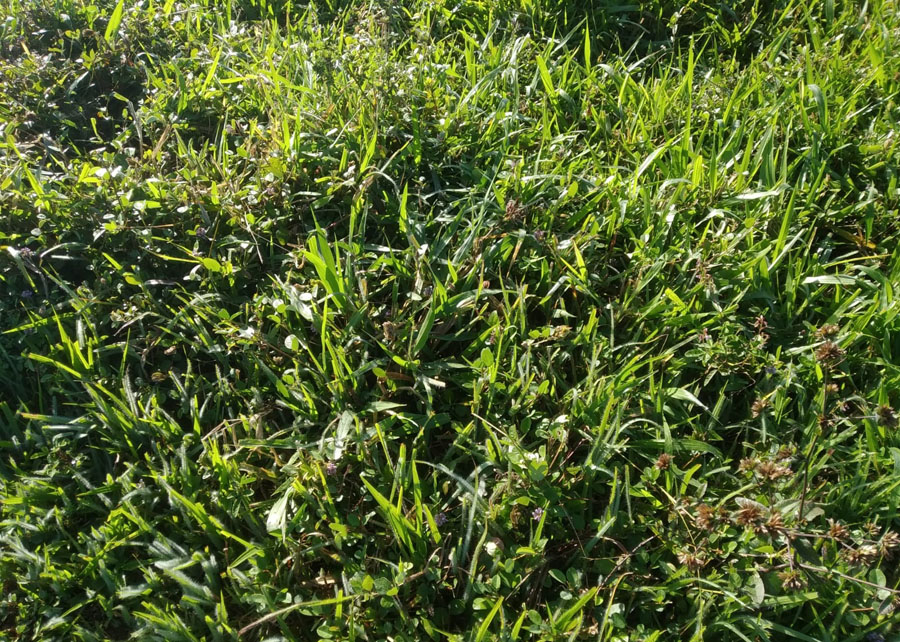 Seeds in cattle feed Seeds in cattle feed
According to Ceplac researcher Cláudia de Paula Rezende, managing desmodium requires just as much other species. The animal scientist has worked for over two decades assessing the use of this and other leguminous species in pastures. "Farmers need to see their pastures as crop to which they must supply enough nutrients so that they become perennial and can yield results both in the animals and in the system as a whole", the researcher comments. Rezende explains that desmodium can be introduced in the pasture at the time the grass is sown with a few recommendations. "You should not sow them together because the seed of this leguminous plant is very small, and if you place it in the sowing machine with the grass seed the latter will fall first", she warns. Thus she considers adding the desmodium seeds to the cattle feed easier. "If we add around 100 grams of non-scarified seeds, the cattle will ingest them and then defecate in the pasture, so the seeds can be set and grow", the animal scientist explains. |
Ana Lucia Ferreira (MTb 16913/RJ)
Embrapa Agrobiology
Press inquiries
agrobiologia.imprensa@embrapa.br
Translation: Mariana Medeiros (13044/DF)
Superintendency of Communications
Further information on the topic
Citizen Attention Service (SAC)
www.embrapa.br/contact-us/sac/
 Busca de Notícias
Busca de Notícias 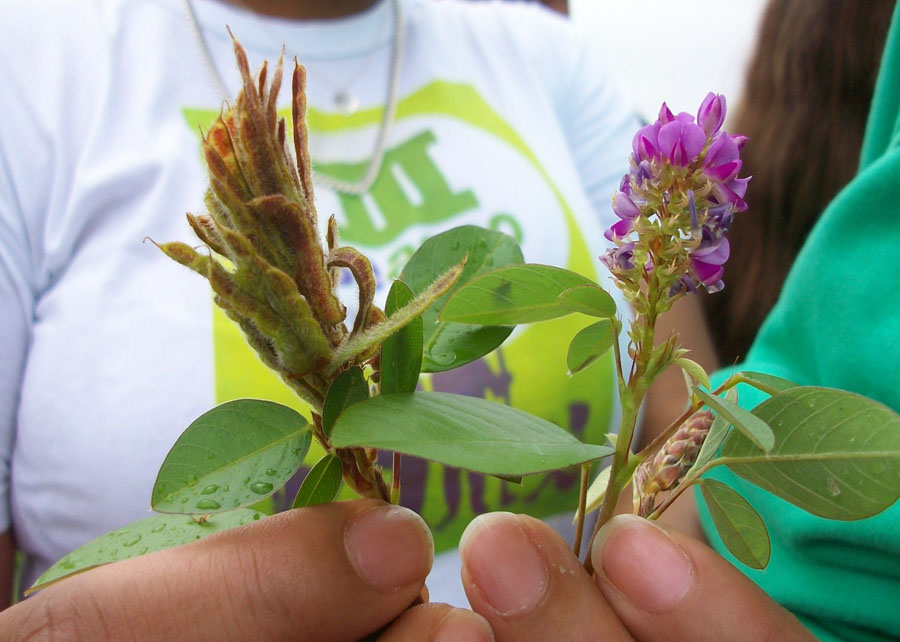
 Resistance to the use of leguminous plants
Resistance to the use of leguminous plants


